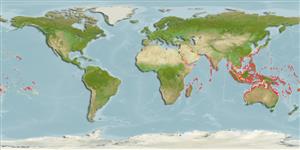Environment: milieu / climate zone / depth range / distribution range
Ecologia
marinhas associadas(os) a recifes; não migratória; intervalo de profundidade 0 - 30 m (Ref. 58304). Tropical; 36°N - 36°S, 28°E - 132°W
Indo-Pacific: East Africa to the Line and Tuamoto islands, north to southern Japan, south to the Lord Howe and the Austral islands. Closely related to Chaetodon decussatus.
Tamanho / Peso / Idade
Maturity: Lm ? range ? - ? cm
Max length : 23.0 cm TL macho/indeterminado; (Ref. 9710); common length : 15.0 cm TL macho/indeterminado; (Ref. 5450)
Espinhos dorsais (total): 13; Raios dorsais moles (total): 23-25; Espinhos anais 3; Raios anais moles: 19 - 22. This species is distinguished by the following characters: snout length 2.5-3.2 in head length; greatest body depth 1.5-1.7 in SL. Body pattern chevron with narrow lines on side; black band across posterior body which does not include entire rear part of dorsal fin (Ref. 90102).
Adults are found in reef flats, lagoon and seaward reefs and sometimes in turbid waters subject to freshwater runoff swimming in pairs. They are omnivorous, feeding on algae, coral polyps, crustaceans and worms (Ref. 5503). They are oviparous (Ref. 205) and monogamous (Ref. 52884). Stable monogamous pairs with both pair members jointly defending a feeding territory against other pairs (Ref. 58331) occur, but often accompany other species without being aggressive. They are easily maintained in tanks. Minimum depth reported taken from Ref. 128797.
Life cycle and mating behavior
Maturidade | Reprodução | Desova | Ovos | Fecundidade | Larvas
Distinct pairing (Ref. 205). Stable monogamous pairs with both pair members jointly defending a feeding territory. Pelagic larvae settle to shallow (<4 m) back reef habitats consisting of rubble, seagrass and low coral cover (Ref. 58331). Monogamous mating is observed as both obligate and social (Ref. 52884).
Myers, R.F., 1991. Micronesian reef fishes. Second Ed. Coral Graphics, Barrigada, Guam. 298 p. (Ref. 1602)
Categoria na Lista Vermelha da IUCN (Ref. 130435)
Warning: mysqli::__construct(): (HY000/1040): Too many connections in /var/www/html/includes/func_getlabel.php on line 46
Can't connect to MySQL database (fbapp). Errorcode: Too many connections
